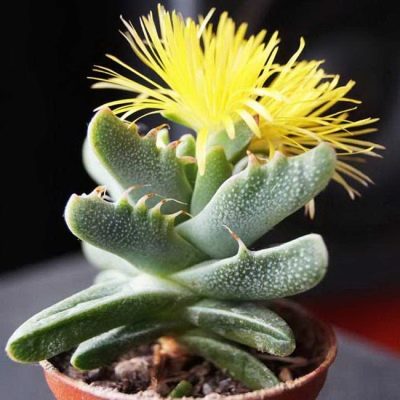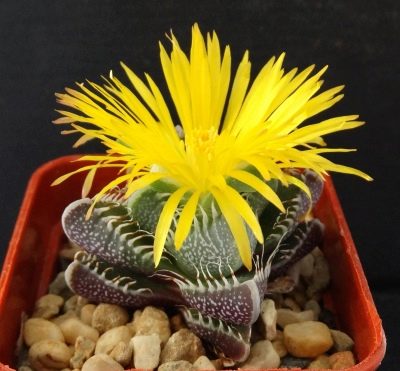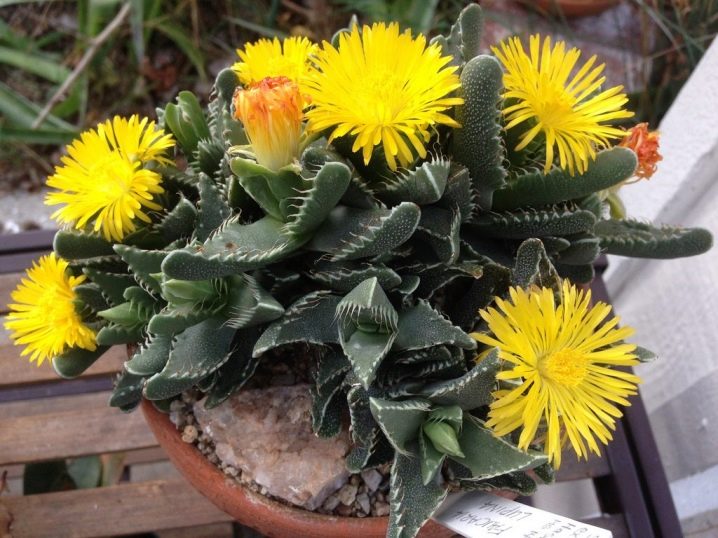All about the faucaria flower

The usual indoor flowers that have been growing on windowsills for years, you always want to dilute with something unusual, a little exotic, but easy to grow and care for. These are the characteristics that the faucaria succulent, representing the Aizov family, is endowed with. Thanks to the efforts of botanists, growing incredibly beautiful faucaria at home has become possible even for beginners.

Description
The faucaria flower was brought to us from distant South Africa, where it lives in the most arid and unfavorable climatic conditions. Faucaria is a miniature succulent that represents the class of perennial plants. Outwardly, the flower is undersized, but very effective due to speckled leaves and huge single flowers.

The plant is characterized by a short but powerful rhizome, thick stem and fleshy leaves. A distinctive feature of the plant is its unusual structure. The central stem grows strongly over time, forming clumps, consisting of numerous succulent leaves. In each leaf rosette with a diameter of 8-10 cm, from 3 to 5-6 pairs of triangular leaflets are formed, arranged crosswise. The color of the leaves can be different - emerald, pale green, with blurred light blotches or brownish veins.
Sometimes relief growths form on the leaf blades, but the edges of the leaves are always hooked and endowed with bristly needles, which give a frightening look, but are absolutely safe for humans.

Faucaria blooms in the summer months - June-July. At this time, single, but rather large flowers with needle-like petals appear on the miniature plant. As a rule, from 1 to 5 buds appear from the central part of the rosette. The flowers can be lemon yellow or snow-white. The diameter of each specimen is 6-8 cm. It is characteristic that the buds bloom only in strong sun. If the day is cloudy, then the bud remains in sleep mode - closed. In addition, the flowers close together for the night. The life cycle of each flower is 7-10 days. In order for an exotic flower to please for a long time, it is recommended to choose the sunniest place for it in the house.

Views
Faucaria has a lot of varieties - there are more than 90 of them. Most varieties prefer to grow in their natural environment, but there are also many types for growing at home. We list the most popular varieties among flower growers and admirers of these beautiful plants.
-
Tiger. A succulent with a powerful central stem, the height of which does not exceed 5 cm. Sitting triangular leaves of a grayish-greenish color completely hide the central stem. On the edges of the leaves are pronounced light processes - teeth. On the tops of the curtains, bright yellow flowers are formed with narrow leaves resembling hanging arrows. The diameter of the flower does not exceed 5 cm.

- Feline. This is a larger view. The height of the central shoot reaches 15 cm. The leaves of the succulent are fleshy, neat triangular in shape, elongated (about 5 cm), dark green in color. A characteristic feature of the variety is the presence of light bristle processes along the entire leaf plate, which outwardly resembles a cat's tongue. At the base of the curtains, very fluffy yellow flowers with needle-like petals appear. Their diameter is about 4-5 cm.

- Tigrina (faucaria tigrina). Another miniature succulent, the central stem of which is no higher than 4-5 cm.The plant is characterized by a diamond-shaped leaf shape with a pronounced sharpening of the ends, as well as the rapid growth of the flower. The color of the leaves is bottle green, diluted with whitish blotches in the form of stripes and miniature specks. The edges of the leaves are strewn with strong teeth with hair-like ends. The plant blooms with golden yellow flowers with a diameter of 5 cm.

- Lumpy. Variety with an elongated central trunk, which is 7-8 cm long, and serrated dark green leaves. A distinctive feature is the branching of the central stem. During the flowering period, light yellow opening buds with a diameter of up to 3-4 cm appear on the plant. The fleshy leaves are triangular in shape and many growths are located chaotically on the leaf plate.

- Bosch. This is an unusual species of faucaria, since it blooms not in summer, but in autumn. A succulent plant is a shortened but thick stem, growing up to 5 cm, covered with abundant triangular leaves, strewn with white dots and needles along the edges. Fleshy leaves up to 4-5 cm long have a feature - the concavity of the plate. Despite the diminutiveness, rather large bright yellow flowers (diameter 8-9 cm) are formed on the plant.

- Candida. This species is characterized by a strong central trunk 5 cm high and a good thickening with fleshy rhombic leaves, which are covered with a large number of teeth along the edges. During the flowering period, large snow-white flowers with a diameter of 8 cm appear on the curtains.

- Britten. A variety with an elongated stem (height 10 cm) and many diamond-shaped leaves 5 cm long. The color of the leaves is unusual - ash green, covered with small dark dots, and the edges are outlined with a dark red edging. The plant blooms with large yellow flowers with a purple-pink tint. The edges of the fleshy leaflets of the plant are marked with curved teeth.

In addition, there are also beautiful, wolf and small-toothed faucaria, which can also be grown at home, having familiarized yourself with the intricacies of planting and caring for an exotic plant.

Growing conditions
An exotic flower is a heat-loving plant that loves the sun. Plant pots are recommended to be placed on windows that overlook the sunny side. In summer, a flower is comfortable at an air temperature of + 25 ... 30 degrees, and in winter a succulent needs coolness: +10 is the optimal microclimate.
It is also worth noting that the flower grows well in rooms with dry air, so it does not need excessive watering and moisture.

The plant is planted in loose, nutritious soil that allows air to pass through well. Cactus soil is often used.
Caring for an exotic plant at home is not difficult, but it must be observed, otherwise the flower will die.
This is what the succulent faucaria needs.
-
Watering as the soil dries. It is advisable that the water is spilled away from the leaves. Irrigation is carried out with warm water with a minimum chlorine content.
-
Fertilization. In the period from April to August, fertilizers are applied - once a month. For this, top dressing for cacti is suitable.
-
Transplant every 2-3 years. The plant is transplanted in the spring. The best will be flat and wide flowerpots with a high-quality drainage layer.

In addition, it is periodically recommended to clean the plant from dust using a brush or soft textiles. In winter, when the plant is in a state of absolute dormancy, it should not be watered.
Reproduction
Faucaria reproduces in two ways - by seeds and shoots. At home, propagation by side shoots is more relevant, since it is much easier than the seed method. The procedure for reproduction by shoots consists of several steps.
-
The shoot is carefully cut off, dried for 4-5 days. It is important that the cut is perpendicular to the stem.
-
The dried shoot is placed in moistened sand.This is done in order for it to take root. This usually takes 3-4 weeks.
-
The container with sand and a shoot should be located in a room where the temperature is stable at + 25 ... 28 degrees.
-
The emerging children are carefully transplanted into separate pots with a prepared substrate.

After 15-20 days, the transplanted plants are watered abundantly with settled water. Reproduction of faucaria from seeds is somewhat more difficult and painstaking. So, the seed method consists of the following activities.
-
Flower seeds are sown in prepared (washed) river sand. It is not necessary to deepen much. Sowing is carried out according to the scheme 1x1 cm.
-
To accelerate germination, a greenhouse effect is provided. For this, the seedlings are covered with glass, and the temperature is maintained at + 23 ... 25 degrees.
-
During the waiting period for seedlings, moderate watering (irrigation) and mandatory ventilation are carried out. Seedlings usually appear in 7-9 days.
-
The plant is dived into individual pots.

The transplantation of the sprouts that have appeared is done in a previously prepared soil. For this, the soil for cacti is optimal.
Diseases and pests
Having provided the flower with proper care, as well as choosing the optimal comfortable place for growth, you can not worry about diseases and pest infestations. Weakened plants can be exposed to gray rot, as well as fusarium and late blight (especially if they grow in a flower bed). Treating the soil with a solution of potassium permanganate with the addition of boric acid will help to eliminate diseases.

Among the pests that can attack the plant, it is worth highlighting the spider mite, mealy or rootbug. You can get rid of parasites through the use of insecticides - wiping the leaves or rinsing the roots. After the procedure, it is advisable to transplant the flower into clean and dry soil.








































































































The comment was sent successfully.